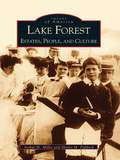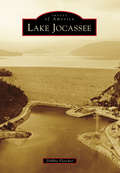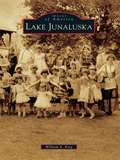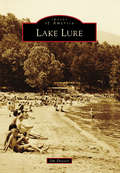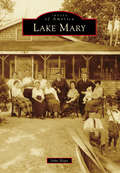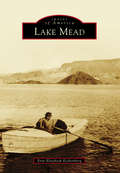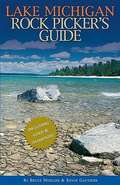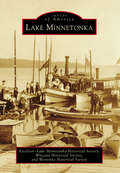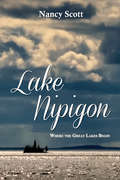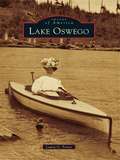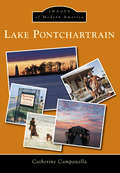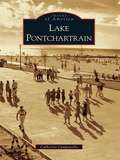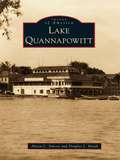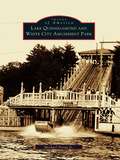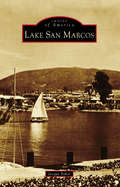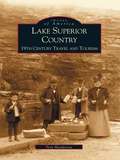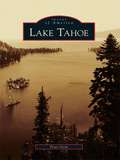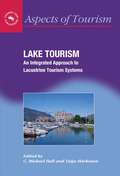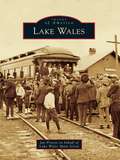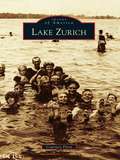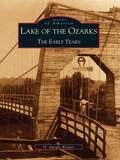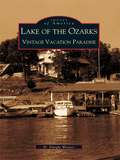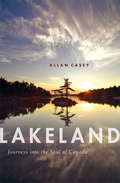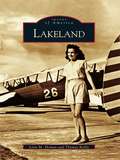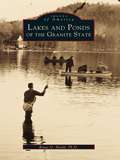- Table View
- List View
Lake Forest: Estates, People, and Culture (Images of America)
by Shirley M. Paddock Arthur H. MillerLake Forest: Estates, People, and Culture is the first book-scaled historical survey entirely focused on this notable Chicago North Shore suburb in a generation, offering a newly visual approach to the community's unique early past. Many of the nearly 200 images have never been published, having been newly discovered in local archives and family collections. From the Civil War to World War I especially, this community of millionaires flourished, giving rise to a diverse whole town-within-a-town whose local industry comprised the estates and their owners. West Lake Forest had been settled by Irish-descendant farmers after 1836, but by 1857 a new sort of community had sprung up further east, between the then-new railroad line along the lake and the shore. It was a wooded, naturalistic, anti-urban suburb, centered on education and faith, established by New England descendant Chicago Presbyterians, and businessmen with their families.
Lake Jocassee (Images of America)
by Debbie FletcherThe creation of Lake Jocassee by Duke Power Company's massive Keowee-Toxaway Project in the late 1960s and early 1970s flooded a quaint mountain valley whose earliest recorded history was in 1539, when Spanish explorer Hernando de Soto led an expedition through the present-day Jocassee Gorges. In 1971, hundreds watched the slow retreat of the Whitewater, Thompson, Horsepasture, Toxaway, and Keowee Rivers as they formed one large lake, smothering homes, lands, and farms in the process. Years of monitoring the water flow through the valley proved initial estimates correct, and Lake Jocassee became the deepwater source it was intended to be, providing an adequate supply of water to generate electricity. Today, a new generation enjoys many recreational activities on what is known as the "Jewel in South Carolina's Crown," a pristine lake surrounded by the Blue Ridge Mountains in Oconee and Pickens Counties.
Lake Junaluska
by William E. KingReligion spread swiftly across our new nation with the help of camp meetings where families, taking a break from farm labor, gathered for inspiration and socializing. The late-19th-century religious experience expanded the concept by adding educational and recreational opportunities. Permanent campgrounds appeared, the most renowned being Chautauqua in New York. In 1913, Southern Methodists created their own institution with the first conference at Lake Junaluska in western North Carolina. Capitalizing on the beauty of the Appalachian Mountains, Lake Junaluska Assembly, a conference center of the United Methodist Church, became an attraction for inspiration, instruction, relaxation, and recreation. Renowned preachers such as Billy Graham and speakers like Eleanor Roosevelt have filled its iconic round auditorium. Approximately 200,000 annual visitors join a residential community to make Lake Junaluska a destination in its own right amid the attractions of nearby Asheville, Waynesville, Blue Ridge Parkway, and Great Smoky Mountains National Park.
Lake Lure
by Jim ProctorLake Lure, North Carolina, is known as the "Gem of the Carolinas." Twenty-five years after Dr. Lucius Morse and his brothers Hiram and Asahil purchased Chimney Rock in 1902, their dream of creating Lake Lure and the town of Lake Lure was realized. Lake Lure is surrounded by majestic mountain cliffs and fed by the idyllic Rocky Broad River. A popular tourist destination, Lake Lure hosted famous figures through the years, including Franklin D. Roosevelt and F. Scott Fitzgerald. Also significant in film history, it provided the backdrop for Dirty Dancing and Last of the Mohicans. Lake Lure showcases the rich community, tourism, and recreational history of this mountain community.
Lake Mary
by John HopeFrom the start, Lake Mary was quiet and friendly, with a quality of life that attracted people of various backgrounds and origins wanting a break from hectic city life. The founding families described their initial experience as "heaven," with men on horseback clomping over dirt roads, dogs running free, ospreys perched in silence, and the echoes of children playing nearby. Underneath the cool shade of Florida oaks and swaying palmettos, women rocked and knitted while men gathered on benches and told valiant stories of catching fish. Since its inception, the Lake Mary City Commission has embraced the so-called "total quality of life," providing homes and work opportunities in close proximity to reduce daily commutes and solidify the sense of community. This led the way to Money magazine naming Lake Mary in 1997 the fourth best place to live and work in the United States.
Lake Mead
by Erin Elizabeth EichenbergThe drastic contrast between its desert landscape and the deep, blue waters of Lake Mead makes it difficult to envision the park's creation as merely incidental. After the completion of the Hoover Dam, the waters of the Colorado River began to flood the river valley and form one of the largest man-made lakes in the United States. The Bureau of Reclamation soon realized the vast recreational opportunities that Lake Mead would provide. Through a memorandum of agreement, the National Park Service was tasked with managing the first national recreation area, formerly known as the Boulder Dam National Recreation Area.
Lake Michigan Rock Picker's Guide
by Bruce Mueller Kevin GauthierAn eagerly awaited rock identification guide for Lake Michigan
Lake Minnetonka
by Excelsior-Lake Minnetonka Historical Society Westonka Historical Society Wayzata Historical SocietyKnown to native peoples for centuries as a sacred place and hunting ground, the ninth largest of Minnesota's 10,000 lakes remained unchanged until its shores were opened to settlement in 1851. The following year, New York promoter George Bertram wrote, "For healthfulness of climate, fertility of soil, beauty of scenery and nearness to markets [it] cannot be surpassed by any other locality in the country, being within twelve or fifteen miles of two of the most important towns in the territory . . . navigable for steam and other boats over forty-one miles, its waters clear as crystal and abounding with fish." Settlers began to flock to Lake Minnetonka's 120 miles of shoreline, clearing the "Big Woods" and building new lives in the wilderness. Soon, the lake became a tourist destination; thousands traveled across the country to stay in its lavish hotels, ride in massive steamboats, and enjoy the lake's beauty.
Lake Nipigon: Where the Great Lakes Begin
by Nancy Scott2017 Gertrude H. Dyke Award — Nominated The history of Lake Nipigon, where the Great Lakes begin. The name Nipigon is evocative of storied brook trout, cold clear waters, elusive woodland caribou, sweeping vistas, and spectacular scenery. Situated in the heart of Northwestern Ontario, almost every map of North America shows Lake Nipigon as a significant geographic feature, yet few people know its story. As the primary watershed that flows into Lake Superior, Nipigon is the headwaters of the Great Lakes. This, the first inclusive historical account of Lake Nipigon, provides a fascinating overview of its extensive natural history, including information on species at risk, and interprets the story of human incursion into the area, from its aboriginal prehistory to the colourful fur trade, the harvesting of resources, the coming of the railway, recreational fishing, eventual settlement, and the communities that remain today.
Lake Oswego
by Laura O. FosterFifteen thousand years ago, the Missoula floods roared out of the Columbia River Gorge and sculpted a lakebed out of an old river channel. In 1847, Albert Durham built a home and mill at the lake's outlet, calling the area Oswego. In the 1860s, iron ore mined from the surrounding hills gave rise to the hope that Oswego would become the "Pittsburgh of the West." Two decades after its hillsides had been logged and the iron industry failed, the city reinvented itself as an elegant streetcar suburb of Portland, a place where people could live where they played. Oswego Lake's shores were soon lined with picturesque homes, and pleasure boats and water-skiers roamed its waters. Arcadia's Images of America: Lake Oswego chronicles the town's bucolic beginnings, industrial heyday, and successful repurposing from a community based on resource extraction to one of Oregon's most beautiful towns, renamed Lake Oswego after a 1960 merger with nearby Lake Grove.
Lake Pontchartrain
by Catherine CampanellaNative Americans used Okwata, meaning "wide water," as a shortcut for inland trade between the Gulf of Mexico and the Mississippi River. When the Europeans arrived, the original inhabitants showed them the route--the settlement near the river became the city of New Orleans, other lakeshore communities grew, and Lake Pontchartrain continued to be a vital waterway well into the 20th century. Aside from its economic value, Lake Pontchartrain was a cultural mecca: Mark Twain wrote about it and jazz sprang from its shores; locals and visitors traveled out to the amusement parks and opera pavilions, simple fishing villages and swanky yacht clubs, forts and lighthouses; and majestic hotels and camps perched precariously over the water. In Images of America: Lake Pontchartrain, photographs document memories of a time that not even Hurricane Katrina could erase.
Lake Pontchartrain (Images of America)
by Catherine CampanellaIn Images of America: Lake Pontchartrain, photographs document memories of a time that not even Hurricane Katrina could erase.Native Americans used Okwata, meaning "wide water," as a shortcut for inland trade between the Gulf of Mexico and the Mississippi River. When the Europeans arrived, the original inhabitants showed them the route--the settlement near the river became the city of New Orleans, other lakeshore communities grew, and Lake Pontchartrain continued to be a vital waterway well into the 20th century. Aside from its economic value, Lake Pontchartrain was a cultural mecca: Mark Twain wrote about it and jazz sprang from its shores; locals and visitors traveled out to the amusement parks and opera pavilions, simple fishing villages and swanky yacht clubs, forts and lighthouses; and majestic hotels and camps perched precariously over the water.
Lake Quannapowitt
by Alison C. Simcox Douglas L. HeathLake Quannapowitt is named for James Quonopohit, a member of the Pawtucket tribe of Nipmuc Indians and signer of the 1686 deed selling land to European colonists. A town called Redding (now Wakefield) developed on the shore of the lake that provided colonists with a bounty of fish, including salmon and alewives, until mills stopped their passage upstream. The town remained rural until the Boston and Maine Railroad arrived in 1845. Overnight, new markets became accessible, and Lake Quannapowitt ice was exported to destinations worldwide. Icehouses dominated the shoreline and stood side-by-side with boathouses and bathhouses. Some in Wakefield remember the last days of ice harvesting, although barely a trace of its existence remains. More residents remember Hill's Boathouse and Dance Hall, where many a romance began. For recent arrivals who walk and jog its idyllic 5-kilometer shore, the lake's industrial and complex past will come as a surprise.
Lake Quinsigamond and White City Amusement Park (Images of America)
by Michael Perna Jr.In the 1800s and well into the 1900s, the area around Lake Quinsigamond, in Shrewsbury and Worcester, was one huge summer resort. Hotels, ethnic and social clubs, boat clubs, a horse racing track, picnic grounds, and two amusement parks, Lincoln Park and White City Park, lined the shore. Steamboats and smaller steam launches transported tourists to the area. Canoes, rowboats, sailboats, and motorboats crowded the lake on weekends. Crew boat regattas, which started in the 1850s, continue to this day. Lake Quinsigamond and White City Amusement Park lets readers experience the attractions, such as the shoot the chutes and White City roller coaster, and enjoy the fun atmosphere during those long-ago summers.
Lake San Marcos
by Jacque BakerIn 1962, the Frazar brothers purchased 1,648 acres of land, which included a 40-acre lake, in San Diego's North County with the goal of building a lakeside community of homes and two golf courses. By 1964, the lake was enlarged to 80 acres and the land was reshaped to accommodate 1,500 homes (eventually growing to over 2,500 homes); two golf courses, one a private country club and the other a public course; and a bridge across the lake. A motel, restaurant, shopping center, and residents' recreation center were later added. In 1967, the National Home Builders Association Convention in Chicago awarded the Lake San Marcos design the title of "Best Planned Lakeside Community in the Nation."
Lake Superior Country: 19th Century Travel and Tourism
by Troy HendersonWhat attracted 19th century travelers to the rugged landscape of Michigan's Upper Peninsula? Most travelers had to brave the frigid, gigantic, and the often-perilous Lake Superior to gain entrance to the Upper Peninsula. But although the lake and rugged terrain often made it difficult for travelers to traverse the Upper Peninsula, it also often made travel an adventurous and enjoyable occasion.Lake Superior Country: 19th Century Travel and Tourism to Michigan's Upper Peninsula will follow these 19th century travelers, from the explorers in search of land titles and valuable mineral deposits in the early part of the century, to "literary travelers" seeking to witness the romantic region made famous by Henry W. Longfellow's poem "The Song of Hiawatha," to the sportsmen and sportswomen who found a bounty of wildlife and fishing grounds. It will also illustrate the various methods of travel undertaken by these people, from birch bark canoes, to steamers, to the railroads, and how these different methods of travel defined the overall tourist experience.
Lake Tahoe: A Maritime History (Images of America)
by Peter GoinThe Washoe Indians called it Tah-ve, an unfathomable liquid sapphire set in a 500 square-mile watershed of alpine snow and ice. Too deep and vast to freeze, Lake Tahoe's waters have, over time, reflected pristine forests, barren hillsides littered with slash and sawdust, managed restoration, and the glow of neon casino marquees. Its spectacular natural landscape, shared by both California and Nevada, is more designed than people realize. Humans transformed most of the old trees into mine shafts and cities. When the railroad, and later the automobile, domesticated the lake, putting it within recreational reach of the middle class, much of Lake Tahoe's shore became a managed wilderness. Its location along a political border created a unique merger of naturalist and gaming economies.
Lake Tourism
by C. Michael Hall Tuija HärkönenLakes are an essential element of some of the world's most popular tourism destinations. However, increased pressure from visitors and the tourism industry as well as from other, sometimes competing, land and water uses has made the sustainable development of lakes increasingly problematic. This book represents the first attempt to bring together some of the key elements of lake tourism within a single volume in order to present the urgent need for an integrated approach to lacustrine tourism systems management.The book presents comprehensive overviews of lake tourism including branding and marketing, visitor management and planning, historical and cultural dimensions, and environmental quality. The volume is international in scope with cases from Europe, North America and Oceania. The book concludes by noting that tourism needs to be established as a complimentary land and water use at a time when lakes and their watersheds are facing challenges in the form of climate and environmental change, increasing numbers of visitors as well as an overall increase in competing demands for water.
Lake Wales (Images of America)
by Jan Privett Lake Wales Main StreetLake Wales, "Crown Jewel of the Scenic Highlands," is nestled among rolling hills and sparkling lakes in the geographic center of Florida. Before the 1900s, this area of the Lake Wales Ridge was considered spectacularly beautiful but uninhabitable because the virgin forests did not have road or railroad access. Only Native Americans and a few white hunters had camped there. G. V. Tillman explored the untamed area in 1902 and fell in love with the beauty. He knew that the land was ideal for citrus, the old-growth pines could provide profits from turpentine, and the natural beauty would attract quality settlers to build a quality town. He shared his vision with three other businessmen, and together they formed the Lake Wales Land Company in 1911. Their timing was perfect. The Atlantic Coast Line Railroad reached Lake Wales that year and brought on the boom time.
Lake Zurich (Images of America)
by Courtney FlynnLake Zurich, a northwest suburb of Chicago, includes a beloved body of water that shares its name and has served as its heart. But the lake did not always bear the same moniker. First known as Cedar Lake because of its many surrounding cedar trees, Lake Zurich was renamed by early settler Seth Paine, who thought its beauty resembled the well-known lake in Switzerland. Early on, visitors from Chicago and beyond journeyed by horse and buggy to relax by Lake Zurich's banks, fish and boat on its sparkling waters, and vacation in summer cottages that dotted its shores. But it has been the people of Lake Zurich who have kept its heart pumping. The celebration of their achievements is apparent throughout town. Parks are named after businessmen and local leaders like Fred Blau and Henry "Hank" Paulus. Schools' names highlight educators like May Whitney and Spencer Loomis. Lake Zurich's legacy will continue through its lake and the people who have loved it.
Lake of the Ozarks: The Early Years
by H. Dwight WeaverSeventy years ago in the Ozarks of southern Missouri, Bagnell Dam was built across the Osage River, creating the beautiful Lake of the Ozarks. Using over 200 images and in- depth captions, author H. Dwight Weaver takes readers back to the origins of this man-made treasure and the towns that surround it. Construction on Bagnell Dam began in 1929, employing thousands of men during the Great Depression. Inundation of the Osage River valley destroyed the area's most fertile farmlands, covered numerous historic sites, and even destroyed Linn Creek, the county seat. But the development also created new towns and a new economy. The images in this new book follow the growth of towns along U.S. Highway 54, including Eldon, Tuscumbia, Bagnell, Osage Beach, and Linn Creek, through the Depression, World War Two, and finally the booming 1950s.
Lake of the Ozarks: Vintage Vacation Paradise
by H. Dwight WeaverWhen the Union Electric Company finished constructing Bagnell Dam in 1931, they had done more than build a source of electrical power-they had created a vacation paradise. Bordered by lush hills and ancient bedrock, the Lake of the Ozarks covers more than 50,000 acres. Since the opening of the lake's first boat docks, three generations of visitors have spent countless days relaxing by its waters. H. Dwight Weaver reconstructs these lazy days, offering readers a vintage tour of one of America's favorite destinations. Each generation witnessed the area's growth, from rustic rock masonry buildings to gravity-defying mystery houses. While travelers in the 1930s and 40s came seeking respite from the Great Depression and World War II, their children and grandchildren returned in happier times, drawn back by the natural beauty and man-made wonders, as illustrated in these historic images.
Lakeland
by Allan CaseyLakes define not only Canada's landscape but the national imagination. Blending writing on nature, travel, and science, award-winning journalist Allan Casey systematically explores how the country's history and culture originates at the lakeshore. Lakeland describes a series of interconnected journeys by the author, punctuated by the seasons and the personalities he meets along the way including aboriginal fishery managers, fruit growers, boat captains, cottagers, and scientists. Together they form an evocative portrait of these beloved bodies of water and what they mean, from sapphire tarns above the Rocky Mountain tree line to the ponds of western Newfoundland.
Lakeland (Images of America)
by Lynn M. Homan Thomas ReillyMunnville, Rome City, and Redbug were just a few of the suggested names for the small Central Florida community that would come to be known as Lakeland. Not long after its founding, other descriptive monikers-"Lovely City of Lakes" and "Highest, Healthiest, Busiest"-would be applied. Recently ranked as the tenth "Best Place to Live" of medium-sized cities in the South, Lakeland today offers an entrancing combination of contrasting elements that all work well together. Fields of strawberries and rolling hills covered with citrus groves surround a growing city comprised of a mixture of structures, both new and old, modern and beautifully preserved. Commercial entities join with cultural organizations in mutually beneficial relationships to produce a quality of life that many other cities only hope to attain. Lakeland may well be as it was advertised in 1905-"Florida's Best Town."
Lakes and Ponds of the Granite State (Images of America)
by Bruce D. HealdNature chose to endow New Hampshire with an infinite variety of lakes and ponds, almost inexhaustible in resources and unlimited in beauty. Each lake holds its own fishing secrets, curving nooks, jagged rocks, and intricate shoreline. For generations, the lakes and ponds have wielded their magnetic force,attracting thousands of residents and visitors in every season of the year. Lakes and Ponds of the Granite State invites you to explore the many wonders of these charmed places. You will see the sun glancing off the wind-flecked surface, hear the breeze rustle the shoreward-bending trees, feel the coolness of the water, and eye a prized trout or two. You will encounter not only those lakes that come to mind first--Winnipesaukee, Sunapee, Squam, and Newfound--but nearly one hundred others, including Dublin and Spofford and the breathtaking Gloriette Lake.
